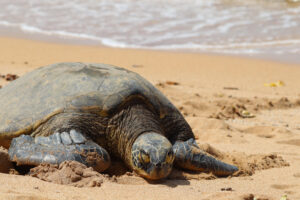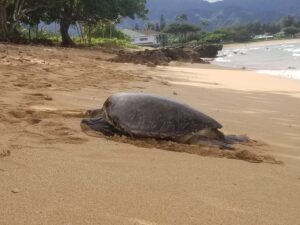Hawaiʻi’s Sea Turtles: Common Questions & Easy Solutions
By Abigail Bearce
Have you ever seen a sea turtle on the beach or in near-shore waters?
Seven species of sea turtles exist worldwide, two of which are commonly found along the shores of the Hawaiian Islands, and one can even be seen on sandy shores. Green sea turtles are the only sea turtles recorded basking and Hawaiʻi is the only place in the world where green sea turtles bask on shore regularly – almost every day! Sea turtles have been observed basking in a few other places, such as Australia and the Galapagos Islands, but not consistently. Typically, sea turtles only leave the ocean and slowly crawl across the sand when they are laying nests. Most male sea turtles never return to land unless they are stranded! However, in Hawaiʻi both male and female green sea turtles have been reported basking year-round.
Why do green sea turtles bask on land?
 Sea turtles are ectothermic, meaning they rely on the environment to regulate their body temperature. Basking is a way to raise their body temperature (thermoregulation), rest, escape potential predators, and improve digestive and immune system functions. Sea turtle basking behavior has been correlated with sea surface temperature; when sea surface temperatures are lower, more basking occurs (Van Houton et. al., 2015). The spatial distribution of sea turtle basking is not well understood. A possible reason basking behavior is only seen consistently in Hawaiʻi may be a trait evolved over time due to how they have been protected on the islands.
Sea turtles are ectothermic, meaning they rely on the environment to regulate their body temperature. Basking is a way to raise their body temperature (thermoregulation), rest, escape potential predators, and improve digestive and immune system functions. Sea turtle basking behavior has been correlated with sea surface temperature; when sea surface temperatures are lower, more basking occurs (Van Houton et. al., 2015). The spatial distribution of sea turtle basking is not well understood. A possible reason basking behavior is only seen consistently in Hawaiʻi may be a trait evolved over time due to how they have been protected on the islands.
What to do if you see a sea turtle on the beach?
When observing a sea turtle on the beach remember to stay a respectful distance of ten feet away. The sight can be alarming for the first time if you are unaware that it is a common occurrence in Hawaiʻi. Here are some common behaviors:
- Sea turtles move slowly on land digging their flippers into the sand and thrusting themselves further up the beach and often stopping for breaks between movements.
- Sea turtles ingest a lot of sea water when they are eating so they will spit up some water because of the pressure of being on land. This is normal! Sometimes algae and seaweed, one type known as limu, is ingested while sea turtles are eating. During digestion the limu turns red and on land they sometimes regurgitate this red sea water, which can look like blood is coming out of their mouth. This is also normal behavior! If you’re not sure however, please call our hotline.
- Sea turtles have special glands near their eyes used to excrete salt water, which can cause them to look like they are crying, but they are just excreting salt.
- For the most part, the sea turtle will be still, maybe opening its eyes every now and then, resting in the sun. It is very difficult to see a sea turtle breathe because of their rigid shell (carapace). However, you might hear them take a big breath, almost like they are sighing.
- Sea turtles can bask for up to 48 hours. If you are aware of a sea turtle on the beach for more than two days please call the HMAR hotline to report this behavior.
If you are concerned or notice visible injuries or fishing gear on a sea turtle, please call the statewide marine animal hotline at (888) 256-9840. Trained HMAR personnel can assess the situation and if needed, dispatch a rescue responder.

Implications of a Changing Climate
Sea turtles depend on habitats around the globe. When baby sea turtles hatch, they scurry to the ocean and embark on a journey into the open ocean, traveling with the currents. Sea turtles are known as umbrella species because they play an important role in many ecosystems they travel through. All species of sea turtles will be impacted as the climate warms and alters the landscape of the ocean.
Basking behavior of green sea turtles is also likely to change. A study examined 6 years of daily basking surveys and sea surface temperature. As mentioned earlier, when sea surface temperatures are lower, more basking occurs (Van Houtan et. al. 2015). Van Houtan et. al. anticipates sea turtle basking in Hawaiʻi could end by 2039 if sea temperatures continue to rise on the current trajectory (2015).
How you can help protect Hawaiʻi’s Sea Turtles
- HMAR Hotline
If you are ever concerned about a sea turtle please report it to the HMAR hotline and trained personnel can assess the situation and dispatch a rescue responder if needed. Statewide, please call (888) 256-9840.
- Decrease emissions
In our day to day lives we can help conserve sea turtles, their incredible behavior, and beautiful habitat by decreasing our emissions. Choosing to walk, bike, or take public transportation when we have the option. A major way to reduce emissions is to buy locally, which reduces demand for transoceanic shipments of goods and also decreases the risk of boat strikes on sea turtles.
- Responsible seafood
One of the biggest threats to sea turtles is discarded fishing gear and commercial fishing operations. Sea turtles can accidentally ingest or become entangled in fishing line left on reefs or rocks causing serious injuries or death. If you see an entangled turtle do not try to disentangle it as this can cause injury or death to the sea turtle and serious injury to the person attempting to help. Instead, call the HMAR hotline as soon as possible. Know where your seafood comes from. Responsible fishers are using barbless hooks, species specific bait to reduce bycatch, and following net rules. Don’t be afraid to ask questions about the food you are buying.
Any and all of these actions help move us towards a healthy ocean ecosystem shared in sustainable harmony between protected marine species and humans. By reporting animals in distress and making small behavior changes for the planet, you are contributing to recovering populations of sea turtles. Mahalo nui for your continued support for marine life and their homes.

References and further reading:
- Van Houtan K., Halley J., Marks W. 2015. Terrestrial basking sea turtles are responding to spatio-temporal sea surface temperature patterns. Biology Letters 11(1). doi.org/10.1098/rsbl.2014.0744
- Visit our Sea Turtle Page.
